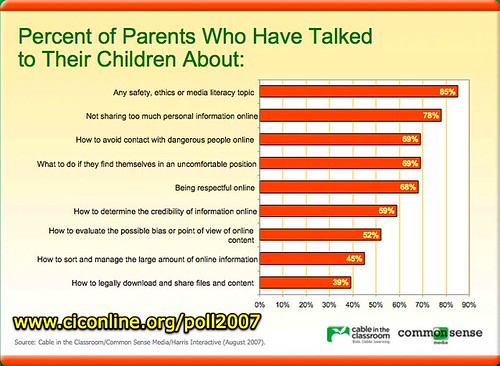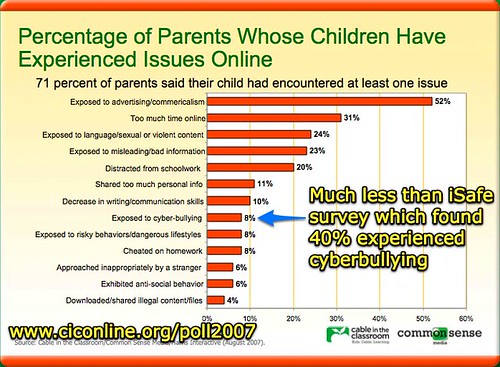According to the September 25, 2007 press release from Cable in the Classroom, “New Poll Finds That Parents Are Taking Proactive Steps To Keep Kids Safe And Smart On The Web:”
…85 percent of parents and legal guardians of children ages 6 to 18 who go online say they have talked to their child in the past year about how to be safe and smart online, and more than 93 percent say they have taken action to make sure the Web sites their kid visits meets with their approval.
Even though the vast majority (71 percent) of parents reported having experienced one or more Internet-related issues with their child within the past year, an overwhelming majority of parents also believe the Internet is helpful to their kids. Parents agreed that the Internet has helped their child to learn skills and information needed to succeed in school (81 percent), learn about different cultures and ideas (74 percent), access current events and news (68 percent), express him/herself creatively (65 percent), and connect to and collaborate with people with similar interests (53 percent).
These report findings are good news amidst a plethora of “bad headlines” relating to Internet safety and online social networking for young people. I have, incidentally, started two new del.icio.us (social bookmarks) tags for good headlines and bad headlines relating to digital social networking and Internet safety. Most of these have been linked previously from my “Safe Digital Social Networking” online curriculum page. I’m going to keep adding to these tagged links in the weeks ahead.
A PowerPoint presentation saved as a PDF file highlighting the poll and its findings is available, as well as a podcast of the press briefing announcing this survey result. Both these media files are linked from the main Cable in the Classroom website for poll results. Today I listened to the complete podcast and reviewed the eighteen slides included in this published presentation. These are some of my key learning points.
In the podcast, “Annie” from Common Sense Media (one of the sponsors of this research effort, and now a graphical link I’ve added in my right blog sidebar) stated that her organization rates all sorts of media for parents to:
…help parents remain the primary influence in their kids’ lives, because right now the average child in the United States is watching an average of 45 hours of media per week and spends only 17 hours with their parents.
This statistic is a key reason for boundaries on all types of media use, as I mentioned in “tips” on the post “Internet Safety: The mistake of talking down to kids.” This is what I call “digital discipline,” and it goes hand in hand with “digital dialog.”
The following slide (#5) from the presentation summarizes some of the “good news” from this poll. More parents than I would guess are reportedly talking to their kids about Internet safety and acceptable digital use issues:
I am trying to be more attuned to the methodologies of surveys like this, in part due to questions I’ve received about the August 2007 “Creating and Connecting” study from workshop participants. This study by Harris Interactive was conducted as a telephone survey on 16-17 August 2007 and included 2,030 adults eighteen years old and older, along with “411 parents or guardians of online children ages 6 to 18.” Is this representative of adults and parents in your local area? There is no way of knowing without doing your own survey of your local population, but I find these results none-the-less interesting and worthwhile.
Over half of the survey’s respondents reported they use some type of filtering or blocking software at home to moderate web use. I was pleased to see that result, but I wonder what the breakdown of that statistic is by the age of students/children? Some of the other research findings included in the report summary (PDF) are broken down by age group, but the percentage utilizing web content filters is not. My perception of parents here in Oklahoma is that fewer than 50% are using web filters at home.
One of the most significant findings from this study was that the more engaged parents are in talking with their children about Internet safety and ethics issues, the more positively they view the Internet’s value for learning. This finding is summarized in the following slide from the presentation summary (page 8):
This survey finding also makes logical sense: The more parents are using the Internet and talking to their kids about its use, the more “enlightened” they will be to understand everything about the Internet is NOT evil. As I generally say in presentations about Internet safety and online social networking, it’s relatively easy to “scare people off the Internet.” It’s good to see that at least for this survey’s sample, a majority of people didn’t have radically negative views about the Internet.
When parents get engaged in communicating with their children about Internet usage, it should be expected that they’ll run into issues and problems encountered in the online environment. This slide shows almost three-fourths of those surveyed reported encountering some type of problem with their children’s use of the Internet:
Some of the results in the above slide (based on parent responses) are contradicted by other studies. According to a presenter during the study’s press conference (available as a mp3 podcast) an iSafe group’s study of students found 40% of students self-reporting incidents of cyberbullying. This contrasts with this Harris Interactive phone survey which found parents saying only 8% of their kids have experienced cyberbullying. We can’t draw certain conclusions, but this seems to suggest parents may not be fully aware of the cyberbullying events taking place in their children’s lives, and are therefore underreporting cyberbullying experiences.
The focus of this survey’s conclusions are similar to others I’ve previously read about: Parents need to maintain open lines of communication with their kids. “Open dialog” is the key. It also suggests tangible benefits of parents having more regular conversations about Internet use and what is acceptable. The more parents are communicating about Internet use with their kids, survey results indicate parents have better perceptions about the benefits of Internet use.
One suggestion from the press conference / podcast that I hadn’t considered, but certainly makes sense, is helping young people choose “gender neutral screennames.” My own experiences last night with my wife venturing for the first time into some Yahoo chat rooms suggest that simply BEING in a chat room, irrespective of your screen name, can be enough to invite direct IM contact by others in the room. We didn’t even type anything, and were contacted after we left the chat room by three different individuals:
Having conversations about website validity and the possible “agenda” of website authors is also suggested by the presentation authors. This is an essential part of media literacy skills, and I heartily agree with their conclusions in this respect. The presenters mentioned that while the survey results indicate many parents ARE talking to students about Internet safety issues, not many are focusing on media literacy and critical thinking in the ways they could and arguably should be.
The need to centrally locate the computer in the home was also emphasized by the presenters. This is a common theme in Internet safety presentations, but something I think is still overlooked or ignored by many parents. Parents who have provided their children with their own television set in their room many view a computer as “just another screen,” and thereby fail to grasp the negative potential of online interaction and website browsing.
The Common Sense Media folks in the press conference maintained that 11-14 year old children are NOT ready for social networking websites like MySpace. I agree when it comes to MySpace, but do think social networking sites like Imbee (specifically created for this age demographic, non-commercial, and set up for students to socially network with their face-to-face friends rather than strangers) ARE appropriate and needed. Students need opportunities to practice safe online social networking, not just theoretically talk about it. Think.com is another free, wonderful environment for students in schools.
This is illuminating research, but it does not suggest educators and other child-advocates should become complacent when it comes to encouraging dialog about Internet safety. I’d like to know the states the 2000+ respondents of this survey live in. It’s good to hear dialog about Internet safety issues is on the rise, but those conversations need to be maintained and expanded. Just as our need to have driver’s education classes and continually focus on road safety will continue as long as we have people driving cars, we’ll need continuing dialog about Internet safety as long as the Internet remains an essential part of our information landscape. I don’t see either of those realities changing in the United States anytime soon.
Technorati Tags:
internetsafety, safety, dsn, socialnetworking, myspace
If you enjoyed this post and found it useful, subscribe to Wes’ free newsletter. Check out Wes’ video tutorial library, “Playing with Media.” Information about more ways to learn with Dr. Wesley Fryer are available on wesfryer.com/after.
On this day..
- Generative AI and Media Tips (Oct 2023) – 2023
- Great STEM Conversations About Perimeter in MinecraftEDU – 2014
- Learning More About Visual Notetaking (Authorized Drawing in Class!) – 2013
- Kansas Honor Flight: October 2012 (Narrated Slideshow) – 2012
- 2012 K12Online Conference Starts Today! – 2012
- Post a Photo to a Photo 365 or 180 Blog – 2011
- Great Ideas from the Fall 2011 DEN Virtual Conference (part 2) – 2011
- Great Ideas from the Fall 2011 DEN Virtual Conference (part 1) – 2011
- Action Research: What Do We Know About Learning in the Cloud? – 2010
- Powerful and Free Tools from the Cloud by Rushton Hurley – 2010





Comments
6 responses to “Research finds positive parent behaviors and attitudes related to Internet safety and use”
[…] American Girl article, brought to you using rss feeds. It’s got some great activity ideas.Here’s a brief portion of the article… believe the Internet is helpful to their kids. Parents agreed that the Internet has helped their child to learn skills and information needed to succeed in school (81 percent), learn about different cultures and ideas (74 percent), … […]
Thanks for the Wes. I’m off to speak to a group of parents this evening on these issues and this comes at a perfect time! All the best.
This is something I’ve been working on with my students since I started teaching children six years ago.
I wasn’t too thrilled with the iSafe questions for the seventh graders about Internet safety. Some kids didn’t know what some of the predator related words (like pedophile) meant. The questions made me feel uncomfortable. I do like their support materials though.
I do think that kids don’t mention cyberbullying to parents as they get into the middle school years. Perhaps they’re on a web site that they shouldn’t be in the first place. I agree that MySpace involves the middle schoolers in a more high school oriented environment than they should be…but it’s just so easy to adjust your birth date and sign on.
I took a quick look at Imbee over the summer and it looked like it’s worth some more investigation in the future. At this point, though, I’m working through wikis and blogs.
You have interesting information here. I always enjoy your articles. I used your Cricket Market VoiceThread as an example to my students before they started creating their own. I think it’s great to share the wider world with our students.
Polling and research aren’t the same thing.
I agree a poll is not the same thing as research, but when a survey is analyzed that constitutes research. This report does not consist of a simple poll result, like a quick USA Today “factoid” graph on the front of one of the newspaper sections. Your comment suggests that this study should be discarded because it is “a poll” and not a serious study. If that is your contention, I disagree with it. I cited the demographics of the survey and indicated I wished we know what U.S. states were represented by the 2000+ respondents. There are limits to any type of research study, and those should be readily acknowledged. Studies based on survey data or polls can still be valuable indicators of trends, perceptions, and behaviors. I think the results of this study should be both studied and considered in the context of Internet safety.
[…] Research finds positive parent behaviors and attitudes related to Internet safety and use » Moving … Teach the children how to (safely) use what’s available, and they will reap the rewards… (tags: mediasavvyyouth) […]